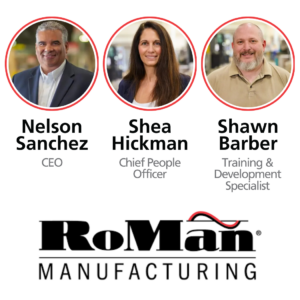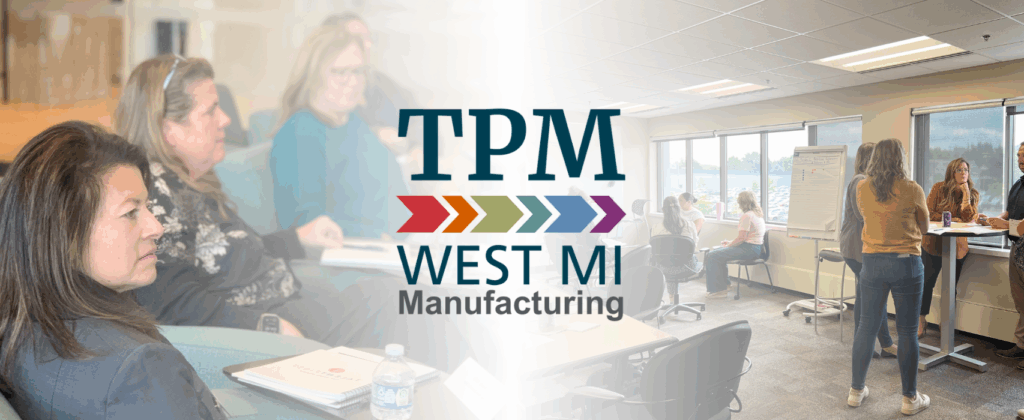Most employers understand the benefits of breaking down the silos that isolate human resources from the rest of the organization. But few have managed to accomplish that.
In surveys for its 2024 Global Human Capital Trends report, Deloitte found that 72% of respondents recognize the importance of shifting HR to a cross-functional discipline. But just 41% were making efforts to encourage that shift, and just 11% reported they were “doing great things.”
 One West Michigan employer that has figured out the advantages — and acted to leverage them — is TalentFirst member RoMan Manufacturing Inc., where HR and operational leaders collaborate to nurture robust learning and development processes.
One West Michigan employer that has figured out the advantages — and acted to leverage them — is TalentFirst member RoMan Manufacturing Inc., where HR and operational leaders collaborate to nurture robust learning and development processes.
“Our strategic objectives are to develop a workforce capable of building world-class products,” said Shawn Barber, RoMan’s Training and Development Specialist. “HR and operation leaders discuss and identify the gaps and establish the learning opportunities to meet the training and development objectives.”
The many benefits of that kind of collaboration — including a better-skilled, more loyal and highly engaged workforce — will be the focus of our next Talent Solutions Series event, Rethink Engagement & Retention.
The session, 9-11 a.m. Nov. 19 at the Pinnacle Center in Hudsonville, will examine strategies to break down HR and operational silos to support workers across the employment lifecycle. (To encourage that cross-functional approach, a discount is offered to organizations that register two or more team members.)
RoMan’s approach
While RoMan has always cultivated a learning environment, those efforts accelerated in recent years, said CEO Nelson Sanchez.
“After COVID, we felt it was imperative that we advance that thinking and make it come to life more and be more formalized,” Sanchez said. “We began work on developing an apprenticeship program and what we call RoMan University today. We had historically had episodic programs that addressed a current need, but we never had anything formalized that brought all the pieces together the way we do now.”
The apprenticeship program, designed to capture institutional knowledge, is now entering its second cohort. It covers four U.S. Department of Labor-supported disciplines: CNC Machinist, Mechatronics, Industrial Technician, and Human Resources.
Additionally, RoMan has worked to establish career pathways and development plans, with advancement and compensation incentives tied to learning participation. This again was the outgrowth of cross-functional collaboration between HR and operational leaders.
“After numerous conversations with long-time operations members, it became clear that we lacked a structured growth and development plan beyond our existing apprenticeship programs,” said Shea Hickman, Chief People Officer.
“To address this, I collaborated with leads and tech leads to identify the true needs for keeping team members motivated to learn and grow. It was also essential for the leads and tech leads to recognize the significance of their role in this process,” Hickman said.
“The question we needed to address was: ‘How do we design a program that focuses on team members’ skills, provides everyone with opportunities to grow, helps them understand how to continue developing within their specific roles, and offers the flexibility to explore opportunities in other areas of production?’”
The power of communication
Barber and Hickman both said their collaborative approach at RoMan revealed that communication is key, and that there is no room for silos.
“At a senior leadership level,” Barber said, “the dedicated weekly meetings help deliver a consistent message throughout the organization. Whether it is between HR and Sales, or HR and Operations, it drives stability all the way to the production level.”
One example is the practice of human resources team members spending time with the production team, Hickman said.
“The first step is to connect with one another and let the conversations flow,” she said. “It’s amazing how ideas blossom just by stopping at a work area to say hello.”
The value of an engaged workforce
The opportunity to gain new skills plays an important role in employee retention and engagement. It also ensures employers can meet the emerging needs of a volatile business landscape.
According to Gallup, organizations with engaged workforces benefit from:
- 78% decrease in absenteeism
- 63% decrease in safety incidents
- 23% increase in profitability
- 68% increase in employee wellbeing
Not every employer has figured this out, however: Gallup reports that just 33% of the U.S. workforce is engaged.
HR and department leaders have an opportunity to collaborate across disciplines to foster greater engagement. The report from Deloitte notes this is more important than ever in the current economic climate:
“As dramatic changes in business, technology, and the world often demand unprecedented agility, responsibility, and the creation of human outcomes, no single function can tackle these on its own: People expertise (within or beyond HR), alongside expertise in other disciplines, will be critical.”


